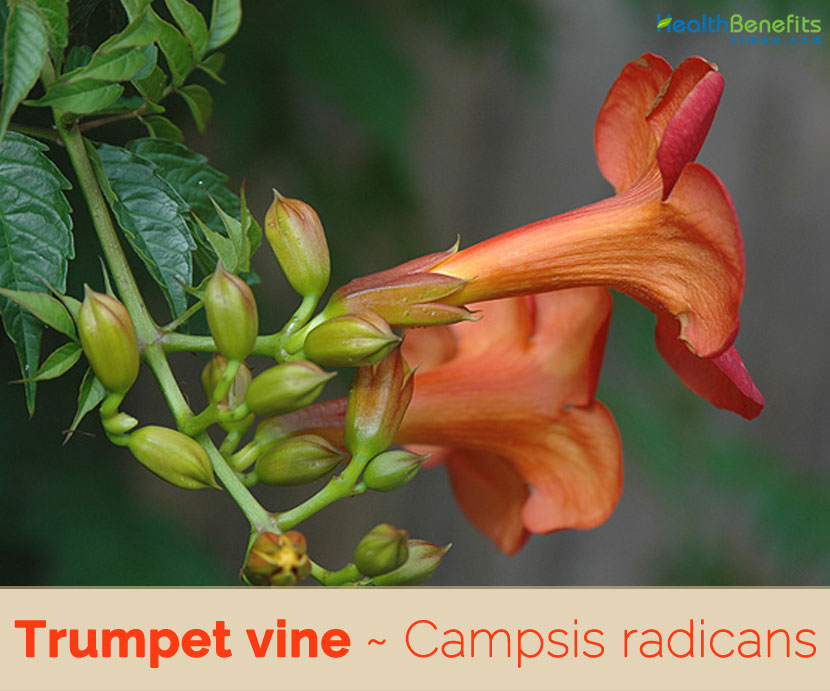| Trumpet vine Quick Facts | |
|---|---|
| Name: | Trumpet vine |
| Scientific Name: | Campsis radicans |
| Origin | Eastern, north-central, and south-central portions of the United States and has become naturalized in New England |
| Colors | Green when young turning to brown as they mature |
| Shapes | Long flat tapered (10-20 cm) capsules, 10-20 cm long which split open when ripe releasing flat winged seed |
| Taste | Sweet, Sour |
Genus name comes from the Greek word kampe meaning bent in reference to the bent stamens on plant flowers. Specific epithet means having rooting stems. Trumpet vine is also commonly known as cow-itch vine because some people experience skin redness and itching after coming in contact with the leaves. Trumpet Creeper usually climbs up trees, shrubs, telephone poles, and other vertical structures using aerial rootlets, otherwise it sprawls across the ground.
Plant Description
Trumpet vine is a dense, vigorous, fast growing, multi-stemmed, deciduous, and woody, clinging vine that grows about 12 m or about 40 feet in height. The plant is found growing in low woods, thickets, open woods, savannas, thickets, riverbanks, disturbed fence rows, roadsides or neglected fields, bottomland forests, swamp forests, old fields, edges of floodplain forests, loess bluffs, woodland edges, gravelly seeps with woody vegetation, limestone glades, lawn trees, telephone poles, railroads and abandoned fields. It is easily grown in a wide variety of soils. It is best planted in lean-to average soils with regular moisture in full sun to part shade. The plant has vigorous running roots and aerial roots are formed in 2 rows below nodes on the stem. Stem is green turning tan and are covered with hair-like aerial roots. Old stems become woody and several inches in diameter. Bark of the mature vine is flaky and light tan. Once the vine climbs to a certain height it grows horizontal branches that reach away from the support in a quest for light and space.
Leaves
Leaves are deciduous, opposite and pinnately compound that is 4-12 in long that cover the vine in a dense cloak of bright green foliage. Each leaf consists of 7-11 ovate or elliptical coarsely toothed leaflets that have serrated edges. The leaflets are about 1-4 in long and 0.5-1.5 in wide and are glossy, bright green and unpalatable to mammalian herbivores.
| Leaf arrangement | Opposite/sub opposite |
| Leaf Type | Odd-pinnately compound |
| Leaf Margin | Dentate |
| Leaf Shape | Ovate |
| Leaf Venation | Pinnate |
| Leaf type and Persistence | Deciduous |
| Leaf blade length | 2 to 4 inches |
| Leaf Color | Green |
| Fall color | Orange |
| Fall characteristic | Not Showy |
Flower
Periodically, short cymes of 2-8 flowers are produced along the length of the vine. Flowers are up to 3½ inch long and have an elongated funnel form shape that is trumpet-like in appearance. The corolla is orange to reddish orange; along its outer rim there are 5 shallow lobes that curl backward. The tubular calyx is reddish orange, leathery in texture, and 5-toothed. It is much shorter than the corolla. Along the inner surface of the corolla, there are reddish lines that function as nectar guides and 4 inserted stamens. There are extra-floral nectaries at the base of each flower. The blooming period occurs during the summer and lasts about 2 months. The abundance of flowers is variable; there is no floral scent.
| Flower Color | Yellow |
| Flower Characteristics | Summer flowering |
Each flower is replaced by an linear elongated seed capsule about 6 inches long, 2-valved, slightly flattened, elliptic in cross-section with noticeable ridges along the sutures between the valves, the valves glabrous, with a leathery texture. As they matures this seed capsule dry and eventually splits apart into two sections to release hundreds of thin brown paper like seeds. The seeds are 6-9 mm long, flattened; the body is elliptic in outline, 2-lobed, brown, with a wing at each end, the wings is papery, light tan, with irregular margins. They are dispersed by the wind.
| Fruit Shape | Pod or pod-like |
| Fruit Length | 3 to 6 inches |
| Fruit Cover | Dry or hard |
| Fruit Color | Brown |
| Fruit Characteristic | Persists on the plant |
Other Facts
- It can be used as a ground cover plant in a sunny position.
- They can be allowed to scramble on the ground and will form an effective ground cover, rooting at intervals along the branches.
- They should be planted about 2.5 meters apart each way.
- radicans is an occasional food source for large mammals and terrestrial birds.
- Showy flowers of trumpet creeper make this plant appropriate for some gardening and landscaping needs.
- It is often used as a cover for fences, arbors, walls, pillars or large trellises and as a ground cover.
- Cigar-like fruit may be considered decorative during winter.
- Vines also provide habitat to ants.
Precautions
- There have been isolated cases reported of people suffering from dermatitis after handling the leaves.
- Avoid its use during Pregnancy.
- Avoid use in case of blood deficiency.
- Eating leaves or flowers may result in minor skin irritation with redness and swelling.
References:
https://www.itis.gov/servlet/SingleRpt/SingleRpt?search_topic=TSN&search_value=34309#null
https://davesgarden.com/guides/pf/go/644/
https://npgsweb.ars-grin.gov/gringlobal/taxonomydetail.aspx?id=8799
https://pfaf.org/user/Plant.aspx?LatinName=Campsis+radicans
http://www.missouribotanicalgarden.org/PlantFinder/PlantFinderDetails.aspx?kempercode=b840
https://plants.usda.gov/core/profile?symbol=CARA2
https://courses.washington.edu/esrm412/protocols/CARA2.pdf
https://edis.ifas.ufl.edu/fp099
http://coastalplainplants.org/wiki/index.php/Campsis_radicans
http://www.theplantlist.org/tpl1.1/record/kew-320348
https://en.wikipedia.org/wiki/Campsis_radicans
https://indiabiodiversity.org/species/show/265956
https://gd.eppo.int/taxon/CMIRA
http://www.naturalmedicinalherbs.net/herbs/c/campsis-radicans=trumpet-vine.php
https://www.wildflower.org/plants/result.php?id_plant=cara2
http://www.flowersofindia.net/catalog/slides/Trumpet%20Creeper.html
https://plants.usda.gov/plantguide/pdf/pg_cara2.pdf
Comments
comments
